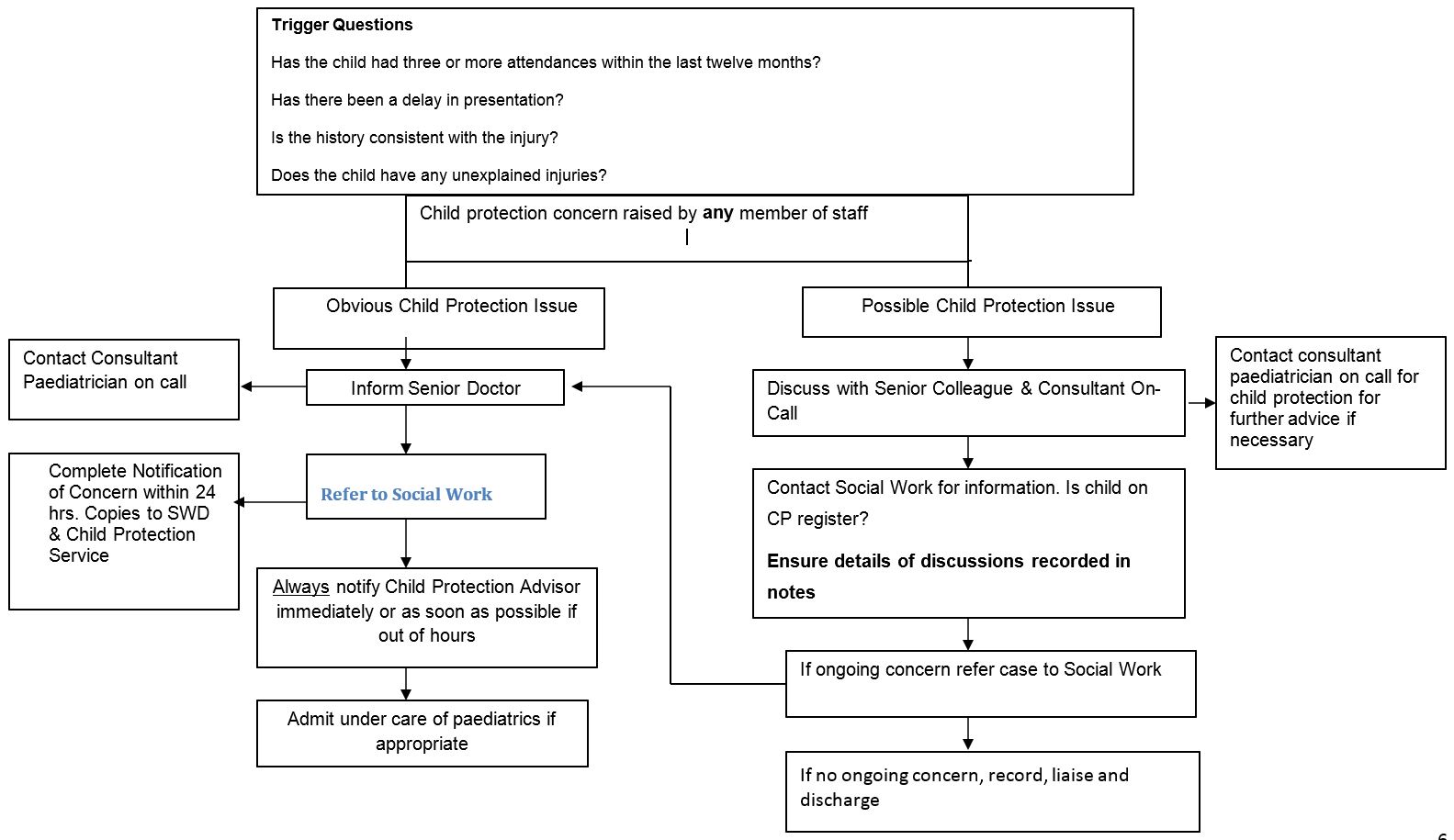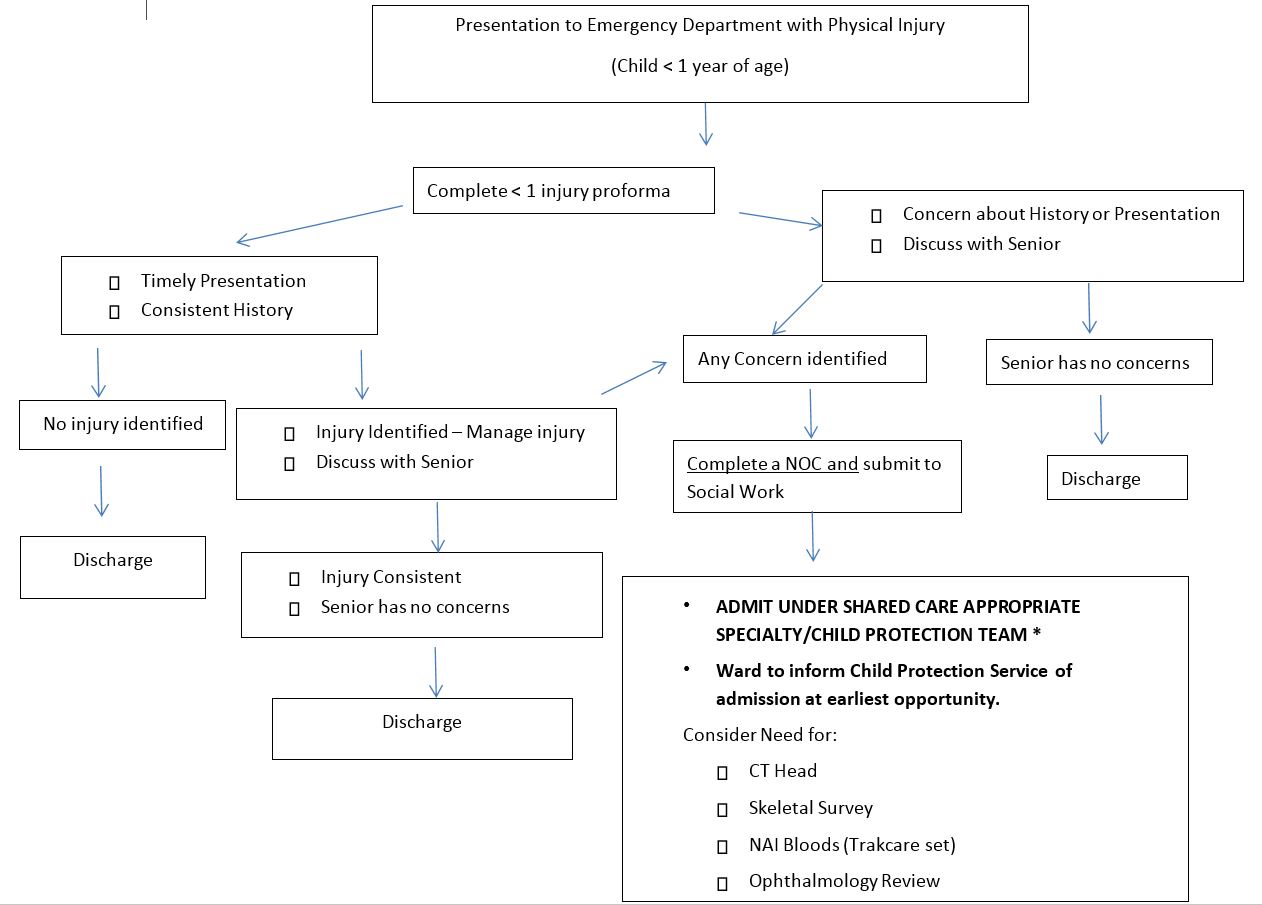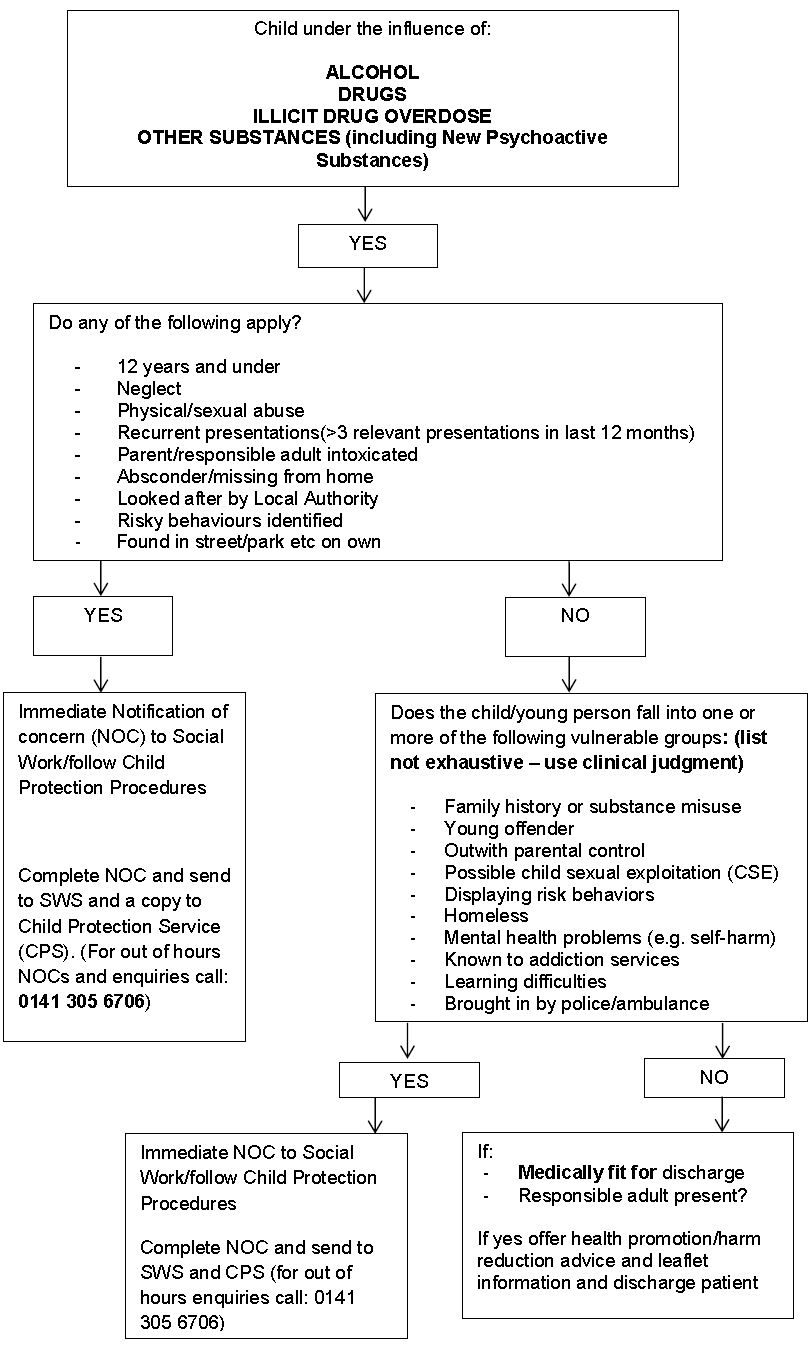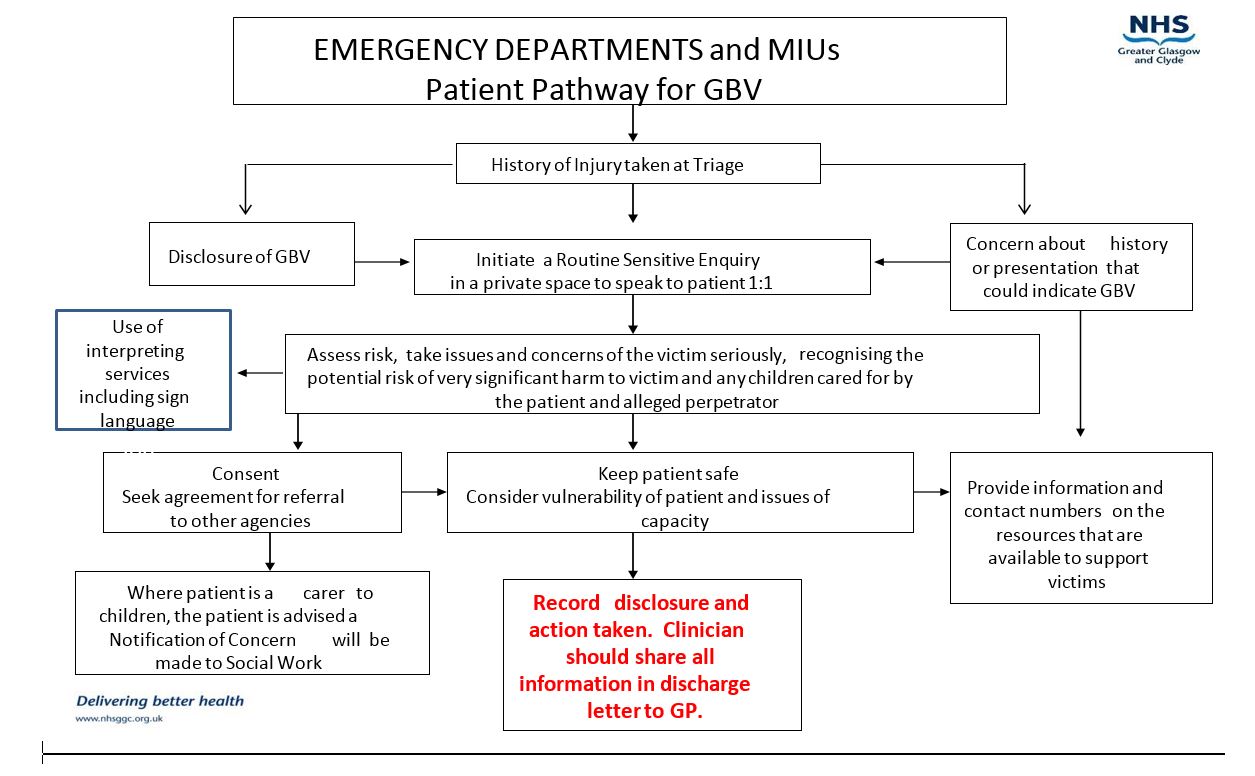Child protection bundle: Emergency Department & Minor Injury Unit (adult & children)
exp date isn't null, but text field is
Child Protection is a challenging area of practice, relying on good communication between different professional agencies to ensure the best care and outcome for a particular child. This guideline has been prepared for health professionals working in Emergency Departments and Minor Injury Units within NHSGGC. It is primarily for professionals who are not specialists in the field of Child Protection and is intended to provide guidance, though is not prescriptive for all situations. These guidelines complement the National Guidance for Child Protection in Scotland (2014) and Child Protection Guidance for Health Professionals (2013).
Staff working within the NHS may be the first to become aware that families are experiencing difficulties in looking after their children (this may include scenarios where adult carers are presenting with an injury/health problem). Staff should share information about any concerns arising from suspicions of abuse or neglect with the social work services, the police or the Children's Reporter at an early stage.” (Guidance for Child Protection in Scotland 2014)
The role of the health professional is to: Observe, Assess, Record and Refer. Participate fully in any investigation and follow on process; Continue to care for the child and family; Record accurately and contemporaneously any concerns, decisions and future plans.
When a child attends an Emergency Department (ED) or Minor Injury Unit (MIU) it is important that the child/young person or accompanying adult where appropriate, gives a history of presenting complaint and previous attendances. See Appendix one below.
Complete Child Protection Questionnaire on Trakcare.
Staff should pay specific attention if there have been 3 or more attendances within a year and there are concerns. All notes pertaining to these visits should be obtained by the clinician.
Staff should check Episode Tree on Trak in order to gather any other relevant information.
For all children, it is essential that all relevant agencies including health visitors, GPs and school nurses are notified of the attendance. Discharge letters for all children are completed by the examining doctor and are sent out from ED/MIU as per local administration procedures. Direct contact can be made to GP/HV to advise of child welfare concerns that require prompt support and/or advice.
When a child presents with an injury and is under the age of one year, the Recognition and Management of Maltreatment in infants under the age of 1 year Guidance must be followed.
An injury proforma must be completed for all children under 1 year, presenting with an injury.
See Appendix Two below for flowchart.
Click here for full Intoxicated Adolescents Guideline.
See Appendix 3 below for flowchart.
Click here for CSE: Recognition & Response Guidance.
See Appendix 4 below for CSE Briefing.
When there are concerns regarding the wellbeing of a child, advice can be sought from a variety of professionals including: Consultant or Senior Doctor in charge, Nurse in charge, Social Work. The Child Protection Service (CPS) is able to offer advice and support, if required. CPS Advisors can be contacted Monday – Friday from 9am-5pm on 0141 451-6605. Paediatric Consultant on call for the CPS can be contacted between 9am-5pm on the same number. Out of hours, contact RHC Switchboard on 201 0000. All actions must be recorded.
If there are concerns that a child is at risk, a check should be made to ascertain whether the child is on the Child Protection Register. Staff should also request any other pertinent social care information regarding the child or their family from Social Work. In hours - telephone numbers in Appendix 6 below. Out of hours – dedicated health telephone line 0141 305 6706. All actions must be recorded.
If a health professional has a child protection concern about a child/young person they must complete a Notification of Concern (NOC) and submit to Social Work Department. The health professional also saves the NOC in portal and a copy sent to Child Protection Service.
Guidance on Raising a Notification of Concern
Where there are concerns regarding the safety of a child he/she must not be discharged without Social Work involvement and the consent of the Doctor in charge of ED. If a child is thought to be in immediate danger then the Police should be contacted. All communications and findings must be fully documented in the child’s records.
Notification of Concern Flowchart - see Appendix 5
Where an adult attends an Emergency Department, any indicators of ‘risk’ such as domestic abuse (Appendix six below), alcohol/drug misuse and mental health issues should act as prompts to practitioners to consider how this might impact on a child who is being cared for by this adult. The staff in ED must always consider child protection in its wider context.
Child Protection Indicators of concern to be found in the following guidance:
NOTE: Clinician examining the child in A&E is responsible for following this pathway



Defining Child Sexual Exploitation
The sexual exploitation of children and young people is often a hidden form of child sexual abuse with distinctive elements of exploitation and exchange . In practice , the sexual exploitation of children and young people under 18 years of age might involve young people being coerced, manipulated forced or deceived into preforming and/or others performing on them, sexual activities in exchange for receiving some form of material goods or other entity. Sexual exploitation can occur through the use of technology and without the child’s immediate recognition.
Why It Matters & Who Does it Affect?
Sexual exploitation of children is child abuse and criminal offence. Children and young people who are exploited sexually can face significant risks to their physical emotional and psychological health and wellbeing both now and in their future. Any Child under age eighteen, male or female, from any background can be a victim of CSE, including those who can legally consent to have sex. The abuse can be perpetrated by adults or peers on an individual or group basis.
Summary of Evidence
- Between 5% and 16 % of children under 16, experience sexual More than 1 in 3 doesn’t tell anyone in childhood. (NSPCC, no-one noticed, no one heard, 2013)
- 2,400 children were victims of sexual exploitation in gangs and groups in 2010/2011
- Over 360 children were trafficked for sexual exploitation last year (NSPCC, 2017)
- Only 2 convictions for the offence of “payment of sexual services of a child” under the protection of children and prevention of Sexual Offences (Scotland) Act 2005 were identified in the Barnardo’s Scotland 2014 paper “Lessons learned from the Jay Report”
Identifying Risk
CSE can be difficult to identify; many children and young people can misinterpret such experiences because they often don’t see themselves as victims. They are led to believe they are in control and making the decisions whereas in reality their behaviour is not voluntary or consensual.
Tell – tale signs include (this list is not exhaustive):
- Staying out late, missing overnight
- Associating with other people involved in CSE
- Missing from education
- Children looked after or accommodated
- Appearing with unexplained gifts such as clothes, mobile phones, sim cards, food , alcohol and cigarette.
- Poor self – care
- Drug and Alcohol misuse, repeat attendances at ED for intoxication
- Sexual inappropriate behaviours
- Repeat attendances for sexually transmitted infections, pregnancy and terminations
- Having older boyfriends/girlfriends
- Self – harm or physical injuries such a bruising
- Feelings of worthlessness and shame
What Can I Do?
Doing nothing is not an option – Do not assume someone else will do something !
- Recognise – Familiarise yourself with CSE and signs that a young person is being exploited.
Ask the right question – children and young people need a therapeutic response from professionals.
- Record – Document your assessment and concerns.
- Report - Discuss your concerns with your Manger/Child Protection Link.
For advice and support contact the Child Protection Service on 0141 451 6605.
If you have concern that a young person under 18 is being sexually exploited you must submit a Notification of Concern to SW
- Refer – Contact Social Care Direct on 0141 287 0555

Either by Email (gg-uhb.CPadmin@nhs.net), Via Task (for EMIS Users) or by Telephoning: 0141 451 6605 (providing CHI number)
Social Work Area Teams Numbers:
Typically SW offices are open-
- Monday to Thursday inclusive: 8.45 am - 4.45 pm
- Friday: 8.45 am - 3.55pm
Out with these times staff should contact Glasgow and Partners Emergency Social Work Service (Standby) on 0300-343-1505
|
Glasgow City |
0141 287 0556 |
|
Glasgow Social Care Direct |
|
Renfrewshire |
0141 618 2535
|
|
Paisley |
|
|
Johnstone |
|
|
Renfrew |
|
East Renfrewshire |
0141 577 8300
|
|
Clarkston |
|
|
Barrhead |
|
East Dunbartonshire |
0141 777 3000 0141 355 2200 |
|
Kirkintilloch |
|
West Dunbartonshire |
0141 562 8800 01389 608080 |
|
Clydebank |
|
|
Dumbarton/Alexandria |
|
Inverclyde |
01475 715 365 01475 715 270 |
|
Greenock |
|
|
Port Glasgow |
Secure email addresses for Children and Families teams to be used for email of child protection notification of concern forms
|
Glasgow City |
||
|
Vale of Leven/Dumbarton |
||
|
Clydebank |
||
|
Renfrewshire |
||
|
East Dun |
||
|
East Renfrewshire – Barrhead area |
||
|
East Renfrewshire – Clarkston area |
||
|
Inverclyde |
||
|
|
||
|
Hospital Based Staff - QEUH and PRMH |
||
|
QEUH |
||
|
PRMH |
||
|
|
||
|
Out of Hours NOC for Hospital Based Staff |
||

Last reviewed: 24 April 2018
Next review: 30 July 2020
Author(s): Wendy Mitchell, Chief Nurse, Head of Child Protection Service
Approved By: Child Protection Forum

